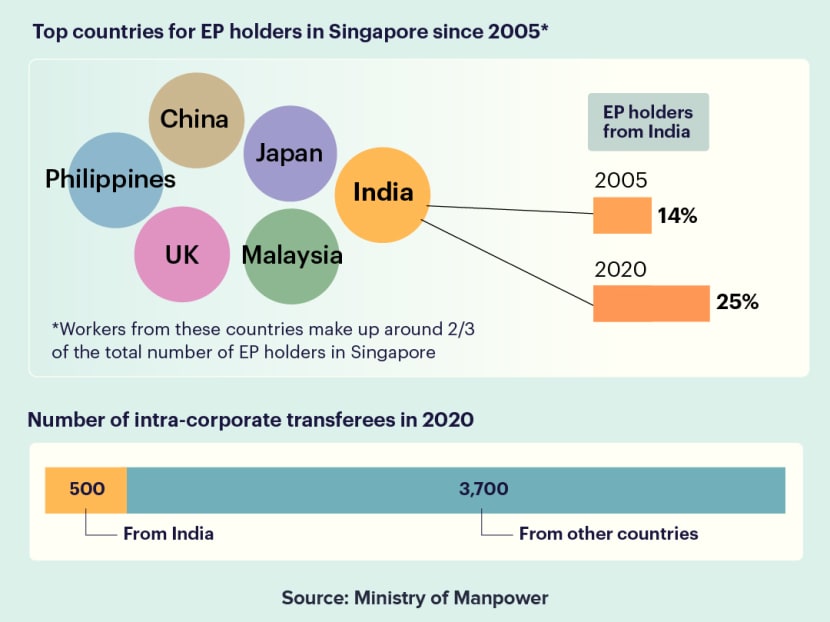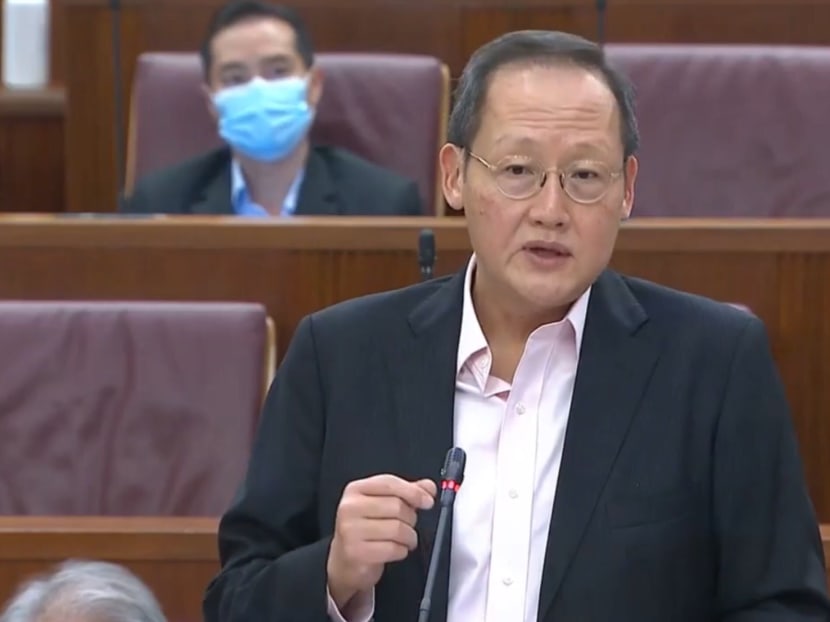Rise in Indian EP holders due to global tech talent trends, not favourable treatment under Ceca: Tan See Leng
SINGAPORE — The proportion of employment pass (EP) holders in Singapore who are India nationals has doubled from about 14 per cent to 25 per cent between 2005 and 2020, Manpower Minister Tan See Leng said in his ministerial statement in Parliament on Tuesday (July 6).
- The percentage of employment pass holders from India has doubled from about 14 per cent to 25 per cent between 2005 and 2020
- Manpower Minister Tan See Leng said this is because of the rapid growth of Singapore’s digital economy and trends in the global demand and supply for tech talent
- He recognised that this has caused social friction and anxiety among Singaporeans
- But Singapore cannot remain close to foreign workers or else multinationals will not invest here
- He also said a common misconception is that if foreigners did not take up these jobs, it would automatically go to Singaporeans
SINGAPORE — The proportion of employment pass (EP) holders in Singapore who are India nationals has almost doubled from about 14 per cent to 25 per cent between 2005 and 2020, Manpower Minister Tan See Leng said in his ministerial statement in Parliament on Tuesday (July 6).
This increase was driven by the rapid growth of Singapore’s digital economy and finance, as well as trends in the global demand and supply for tech talent, Dr Tan said.
It was not because India nationals are given “favourable treatment” under the Comprehensive Economic Cooperation Agreement (Ceca), which is the free trade agreement between Singapore and India.
Dr Tan also pointed out that there was a misconception that if India nationals did not take up such jobs, these positions would go to Singapore residents instead.
While there is a “good Singaporean talent pool”, it was not enough to meet the needs of multinational enterprises investing in Singapore, he said.
Reiterating what the Government has said before, Dr Tan added that Singapore cannot close itself off to foreign workers and tell foreign investors that they hire only Singaporeans, because this would lead to many not investing here.
Dr Tan delivered a ministerial statement on this political hot potato after Non-Constituency Member of Parliament Leong Mun Wai from the Progress Singapore Party (PSP) said that he will take on the challenge by Law and Home Affairs Minister K Shanmugam, who invited him to table a parliamentary motion on Ceca when Parliament sat in May.
In a Facebook post last week, Health Minister Ong Ye Kung said that there has been an "undercurrent of sentiment against immigrant Indians", fuelled “in no small part” by false allegations by PSP on Ceca.
NATIONALITIES OF EP HOLDERS
Addressing the concern that many EP holders are India nationals, Dr Tan said that the countries where most EP holders come from are China, India, Japan, Malaysia, Philippines and the United Kingdom.
These nationalities have made up two-thirds of all EP holders since 2005.
While the percentage of EP holders from India has doubled since 2005, that of EP holders from China has remained relatively stable.
Dr Tan said that while China and India are two of the largest suppliers of tech talent globally, many startups worth more than US$1 billion have emerged in China.
This has led to many Chinese staying put in their home country to work.
India nationals with tech skills, however, continue to look overseas, partly because they have the advantage of being able to speak English, Dr Tan said.
The immigration of India's tech professionals is not unique to Singapore, Dr Tan said as he gave the example of how India is now the second largest source of immigrants in the United States and the third largest in the United Kingdom.
Dr Tan also clarified that Ceca does not allow EP holders “unfettered access” to Singapore’s labour market because those who are transferred here still have to meet work pass criteria set by the Ministry of Manpower (MOM).
The total number of EPs who have transferred is also “very small”, he said. Last year, there were a total of 4,200 of them, with 500 coming from India.
“Given our relative shortage of manpower, even if the workers don’t come from India, they will come from somewhere else. Now I hope that Mr Leong is not objecting to Indians per se. The point is: Are they helping our companies, are they helping us to grow our economy and create better Singaporean jobs? The answer is yes,” he said.
Dr Tan acknowledged, however, that this increasing concentration has caused social friction and anxiety among Singaporeans and this is understandable and to be expected given the transient nature of EP holders.
“Apart from some EP holders who settle down and become permament residents or Singapore citizens, most of them, most EP holders work here for a few years, and they either return home or move on elsewhere. So it is to be expected that they are different and we feel they are different,” he said.
The current situation with India nationals, Dr Tan said, is similar to what happened in the the 2000s when there was some anxiety when the share of China nationals working in Singapore increased significantly.
“We have to bring in the talent and skills to keep our economy growing, while tracking that the number of foreigners in our midst stays at a level we are able to cope with, and manage the social frictions that will arise from time to time. This is a series of trade-offs.
“It is not a once-off adjustment. It is a constant balance that we have to continuously monitor and get right.”
He added that the Government does monitor the concentration of nationalities in firms through the Fair Consideration Framework.

SINGAPORE’S TALENT POOL
Giving the example of a company that needs to hire 3,000 people but can only find 2,500 Singapore residents suitable, Dr Tan said that if the Government did not allow the company to bring in 500 foreigners to fill in the rest of the positions, it would not choose to invest in Singapore.
This in turn would mean that 2,500 residents here would have been deprived of jobs.
“The simple point is that while we have a good Singaporean talent pool, our pool is not large enough to fulfil all of the needs, the breadth and the depth of these enterprises. And very often also, foreigners bring in skills that complement the Singaporeans’ skill sets as well.
"The misconception is that if we said ‘no’ to the foreigners coming in... these jobs they would have taken will therefore all go to Singaporeans,” he said.
There are now about 22,000 positions for professionals, managers and executives (PMEs) that are unfilled, Dr Tan disclosed.
He disagreed with Mr Leong, who had said previously that reducing the number of foreigners will reduce the displacement of older PMEs.
Dr Tan said that there will always be some displacement of PMEs, whether younger or older, because industries change and companies relocate.
“Whether we have foreigners or not, this will not change. It is a function of the business world.
"What matters is whether we are able to find jobs for these displaced PMEs. To do this, we need an ecosystem where there are also new companies willing to come and start up in Singapore, new investments, new foreign direct investment coming in, and expanding multinational corporations.”
Dr Tan said that such a strategy has worked well for Singapore so far. While the number of EPs has increased by around 112,000 from 2005 to 2020, the number of resident PMEs went up by 380,000 over the same period.
Referring to critics questioning how much of this growth has gone to “born and bred Singaporeans”, he said that the majority went to Singaporeans born here over the last decade, not before noting the divisive intent of such questions.
There are 177,000 EPs in Singapore’s foreign workforce as of last year, with most of them in the information and communications technology (19 per cent), professional services (19 per cent) and finance sectors (15 per cent).
Nevertheless, Dr Tan recognised that displaced PMEs have to be helped.
He highlighted several programmes that the authorities have set up to help Singapore workers upgrade their skills and find jobs, such as the SkillsFuture and the SGUnited Jobs and Skills Package.
Dr Tan also said that safeguards are in place to ensure that Singapore workers are not unfairly treated in the employment market, such as having quotas and levies in place for S Pass and work permit holders.
While levies and quotas are not imposed on EP holders due to fierce competition for their talent globally, he said that the Government has focused on raising the quality bar for EP holders through salary requirements.
Mr Leong had suggested imposing a S$1,200 levy on EP holders to correct the disadvantage that Singapore workers face due to the extra costs employers have to bear by contributing to their Central Provident Fund (CPF).
However, Dr Tan said that this is not the right way to manage foreign PMEs. The Government accounts for CPF contributions as part of cost to employers when setting the appropriate qualifying salary for EP holders.
Dr Tan added that all 127 categories of professionals under Ceca come under MOM’s regular work pass framework and there is no “professional visas” category as Mr Leong had claimed.
He reiterated that the Government has no tolerance towards discriminatory hiring practices and all employers are required to comply with the Fair Consideration Framework.
Companies also have to first advertise vacancies on the MyCareersFuture job site first to Singaporeans before they can hire foreigners.
Dr Tan acknowledged that not all companies will play by the rules and that the Tripartite Alliance for Fair and Progressive Employment Practices (Tafep), which handles employment disputes, does investigate cases of nationality discrimination.
Over the past three years, Tafep has handled an average of 170 nationality discrimination cases from complaints yearly.












